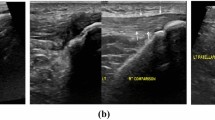Abstract
Hand knob infarction (HKI) is a rare clinical condition which is often misdiagnosed as peripheral neuropathy. This study aimed to identify the clinical characteristics and risk factors of HKI. Nine HKI patients admitted between January 2013 and March 2016 were confirmed by magnetic resonance imaging. Their medical records were collected and analyzed. The modified Rankin Scale was used to assess clinical outcomes. Routine laboratory tests, electrocardiogram, echocardiography, cranial magnetic resonance imaging, magnetic resonance angiography, computed tomography angiography, and Doppler ultrasonography examinations were performed. Seven patients had uniform involvement of all digits. One patient with radial weakness had a lesion in the lateral area of hand knob, and another patient with ulnar weakness had a lesion distributed in the medial area of hand knob. Hyperhomocysteinemia was a most common risk factor for HKI. Most HKI patients had a benign disease course, but three patients (33.33%) with the stroke type of large artery atherosclerosis had disease recurrence. We characterized clinical characteristics and risk factors of HKI which will help the diagnosis and management of HKI.


Similar content being viewed by others
References
Yousry TA, Schmid UD, Alkadhi H et al (1997) Localization of the motor hand area to a knob on the precentral gyrus. A new landmark. Brain 120:141–157
Timsit S, Logak M, Manai R, Rancurel G (1997) Evolving isolated hand palsy: a parietal lobe syndrome associated with carotid artery disease. Brain 120:2251–2257
Kim JS (2001) Predominant involvement of a particular group of fingers due to small, cortical infarction. Neurology 56:1677–1682
Gass A, Szabo K, Behrens S, Rossmanith C, Hennerici M (2001) A diffusion-weighted MRI study of acute ischemic distal arm paresis. Neurology 57:1589–1594
Celebisoy M, Ozdemirkiran T, Tokucoglu F, Kaplangi DN, Arici S (2007) Isolated hand palsy due to cortical infarction: localization of the motor hand area. Neurologist 13:376–379
Takahashi N, Kawamura M, Araki S (2002) Isolated hand palsy due to cortical infarction: localization of the motor hand area. Neurology 58:1412–1414
Alstadhaug KB, Sjulstad A (2013) Isolated hand paresis: a case series. Cerebrovasc Dis Extra 3:65–73
Chen PL, Hsu HY, Wang PY (2006) Isolated hand weakness in cortical infarctions. J Formos Med Assoc 105:861–865
Castaldo J, Rodgers J, Rae-Grant A, Barbour P, Jenny D (2003) Diagnosis and neuroimaging of acute stroke producing distal arm monoparesis. J Stroke Cerebrovasc Dis 12:253–258
de Medeiros FC, Viana DCR, Cunha MN, Hatasa CC, Araújo RV (2017) Pure motor monoparesis due to infarction of the “hand knob” area: radiological and morphological features. Neurol Sci 38:1877–1879
Peters N, Muller-Schunk S, Freilinger T, During M, Pfefferkorn T, Dichgans M (2009) Ischemic stroke of the cortical “hand knob” area: stroke mechanisms and prognosis. J Neurol 256:1146–1151
Granziera C, Kuntzer T, Vingerhoets F, Cereda C (2008) Small cortical stroke in the “hand knob” mimics anterior interosseous syndrome. J Neurol 255:1423–1424
Rankin EM, Rayessa R, Keir SL (2009) Pseudoperipheral palsy due to cortical infarction. Age Ageing 38:623–624
Adams HP Jr, Bendixen BH, Kappelle LJ, Biller J, Love BB, Gordon DL, Marsh EE (1993) Classification of subtype of acute ischemic stroke. Definitions for use in a multicenter clinical trial. TOAST. Trial of Org 10172 in Acute Stroke Treatment. Stroke 24:35–41
Lee SJ, Lee DG, Moon HJ, Lee TK (2017) Lesion pattern, mechanisms, and long-term prognosis in patients with monoparetic stroke: a comparison with nonmonoparetic stroke. Biomed Res Int 2017:9373817
Funding
This study was funded by a grant from the National Natural Science Foundation of China (No. 81271309) and a grant from the Natural Science Foundation of Beijing Municipality (No. 7122067).
Author information
Authors and Affiliations
Corresponding author
Ethics declarations
This study was approved by the ethics committee of Beijing Chaoyang Hospital. All patients gave their informed consents after the inclusion in this study for follow-up.
Conflict of interest
The authors declare that they have no conflict of interest.
Rights and permissions
About this article
Cite this article
Wang, Y., Dong, Q., Li, Sj. et al. New clinical characteristics and risk factors of hand knob infarction. Neurol Sci 39, 857–862 (2018). https://doi.org/10.1007/s10072-018-3278-5
Received:
Accepted:
Published:
Issue Date:
DOI: https://doi.org/10.1007/s10072-018-3278-5




